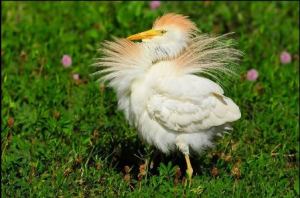by Chris Eberly
Herons and egrets have always been at the center of fashion. In the early 1900’s, they were killed by the thousands so their flashy breeding plumes could adorn women’s hats. These plumes were quite the fashion statement of the day. Fortunately, the Migratory Bird Treaty of 1916 put a halt to the senseless slaughter of these and other migratory birds. But just what was it about these birds that attracted the attention of the millinery trade of a century ago?
Great Blue Heron adult and chick by Janie Lee
Most birds undergo a molt of their feathers once or twice a year. And while in the human species the woman dresses to attract the male of the species, in birds it is the opposite. For instance, male warblers molt into beautiful and colorful feathers for spring migration and the subsequent mating season. Female warblers remain “drab” in comparison, but when incubating eggs on a nest this lackluster appearance is actually a necessary camouflage for blending in and not being seen by potential predators.
But when it comes to bright and flashy plumage to attract a mate, herons and egrets are the undisputed champs of avian high fashion. Many heron and egret species enhance their appeal to potential mates through changing the colors of their bills, lores (the area between the eyes and nostrils), legs and feet. When these colors are at their height, the birds are said to be in high breeding plumage. If you are out and about where these birds are, you may notice this impressive coloration. Great Egrets adopt an almost neon green color in their lores and they grow long plumes on their wings which they can extend out into a circular display on their back. This is what must have caught the attention of hat makers in the 1900’s. The head and neck of Little Blue Herons become reddish-purple and legs and feet become black in high breeding plumage. Cattle Egrets sport orange-buff plumes on the crown, back, and foreneck, the legs become dusky red, and the bill becomes red-orange with a yellow tip. In both Yellow-crowned and Black-crowned Night-Herons the normally yellow legs turn bright pink. Great Blue Herons grow ornate plumes on the head, neck, and back. Even White Ibis join the fashion show, as their facial skin, legs, and bill turn a brilliant scarlet.
Cattle Egret by Joe Fischer
However, the champion of high fashion, in my opinion, is the Snowy Egret (although the Roseate Spoonbill could be a worthy contender). You have probably seen this bird – the white egret with the black bill, black legs, and bright yellow feet during most of the year. When the Snowy Egret gets its high breeding fashion on, it must make the other herons envious. First, it gets a shaggy crest. Next its lore color changes from yellow to an incredible shade of red. And to top it off, its already flashy yellow feet transform into a brilliant orange that nature has no business making.
Snowy Egret by Joe Fischer
I hope you can witness Mother Nature in her finest fashion hour. But just like the latest fashion trends from Paris, the herons of high fashion are here today and gone, well, soon!
Chris Eberly is Associate Director at the Gulf Coast Bird Observatory.
Filed under: Birding
![]()



